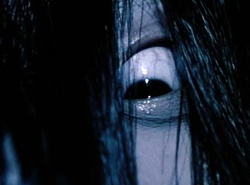 Character: Sadako
Character: SadakoActor:Inou Rie / Shirai Chihiro
Film: Ring (1998)
Badass Moment: Sadako is ready for her close-up, Mr. DeMille (pictured).
For a high-contrast example of the difference between Japanese and American horror films, all you have to do is watch Ring (1998) and its American counterpart THE Ring (2002). Each film lays out, in unambiguous terms, the devices of choice for its respective genre: Ring (sometimes romanized as Ringu) creeps you out with uncertainty and indecipherable imagery, while The Ring prefers to make you jump out of your seat with jolting music cues and sudden shots of disfigured corpses.
What most Japanese moviegoers cite, however, as Ring's number one agent of cinematic trepidation is not the creepy business of dead people with contorted facial expressions. That is, unless you count the contorted facial expression pictured above, which belongs to the super-scary killer ghost known as Sadako.
I won't pick one version of this horror story as "better," as both have their strong points. But I will say this: Samara, Sadako's equivalent in the American remake, cannot even approach Sadako's badass factor...mostly because, in a bizarre decision by the makers of the American version, Samara was given dialog. And not good dialog, either. Stupid, bad, un-scary dialog.
Even in a market that is increasingly polluted with movies that use "creepy kids" in their failed attempts to be scary, Sadako stands out (crawls out?) as a shining example of what a great ghost should be: Quiet, lurching and tragically hirsute.
Sadako, you are a silent badass. We salute you.
Technorati: Ringu / The Ring / リング / ghosts / bad dialog
 Not counting the Virginia Tech shootings, the death of Boris Yeltsin, the shooting of Nagasaki's governor by a jilted yakuza, the firing of Don Imus,
Not counting the Virginia Tech shootings, the death of Boris Yeltsin, the shooting of Nagasaki's governor by a jilted yakuza, the firing of Don Imus, 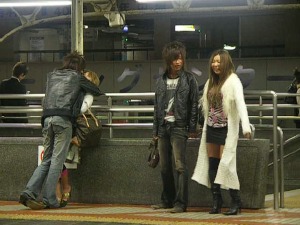 A few minutes shy of midnight, we cut our celebration short. And not at all too soon; I manage to catch the very last train to Shinjuku, as well as the last train from Shinjuku to my home. As I'm waiting for the Yamanote Line at Ueno Station, I see a pair of young couples with identical fashion sense on the platform opposite me, drunkenly stumbling around and making out with each other. In this picture, the guy on the left has a girl underneath him.
A few minutes shy of midnight, we cut our celebration short. And not at all too soon; I manage to catch the very last train to Shinjuku, as well as the last train from Shinjuku to my home. As I'm waiting for the Yamanote Line at Ueno Station, I see a pair of young couples with identical fashion sense on the platform opposite me, drunkenly stumbling around and making out with each other. In this picture, the guy on the left has a girl underneath him.
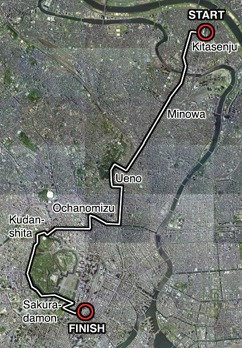 Start time: 11:00 AM
Start time: 11:00 AM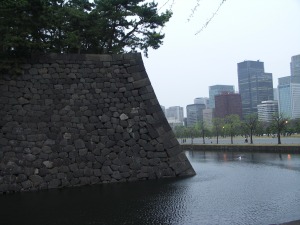 With daylight running out in a hurry, we go southeast from Sakuradamon toward Hibiya Park, which turns out to be a much nicer park than I thought, albeit crawling with stray cats. Unfortunately, I don't have any good photos of Hibiya Park to post here; this one is from the outside of the palace grounds' southeast corner.
With daylight running out in a hurry, we go southeast from Sakuradamon toward Hibiya Park, which turns out to be a much nicer park than I thought, albeit crawling with stray cats. Unfortunately, I don't have any good photos of Hibiya Park to post here; this one is from the outside of the palace grounds' southeast corner.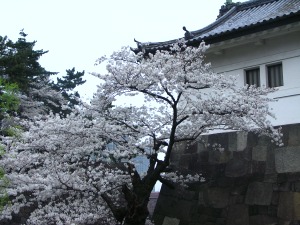 The southernmost entrance to the palace grounds is called Sakuradamon, which means "cherry blossom field gate." An observant student of the Japanese language could make a joke about the name, as the Japanese sentence "Sakura da mon!" sounds like a childish whine to the effect of, "But Mom, they're cherry blossoms!"
The southernmost entrance to the palace grounds is called Sakuradamon, which means "cherry blossom field gate." An observant student of the Japanese language could make a joke about the name, as the Japanese sentence "Sakura da mon!" sounds like a childish whine to the effect of, "But Mom, they're cherry blossoms!"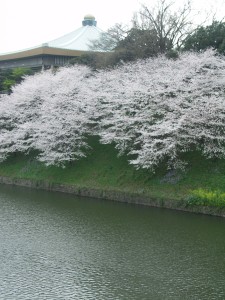 One of this year's prime targets is Kudanshita in Chiyoda Ward, on the northwest side of the vast Imperial Palace grounds. On the first Big Walk, Kudanshita and Chidorigafuchi proved to be the most photogenic hanami locations of all. In the background is the Nihon Budokan, home of martial arts exhibitions and Cheap Trick concerts. It must be convenient for the Emperor to live so close to Tokyo's best-known rock concert venue. I bet he knows the words to "Surrender."
One of this year's prime targets is Kudanshita in Chiyoda Ward, on the northwest side of the vast Imperial Palace grounds. On the first Big Walk, Kudanshita and Chidorigafuchi proved to be the most photogenic hanami locations of all. In the background is the Nihon Budokan, home of martial arts exhibitions and Cheap Trick concerts. It must be convenient for the Emperor to live so close to Tokyo's best-known rock concert venue. I bet he knows the words to "Surrender."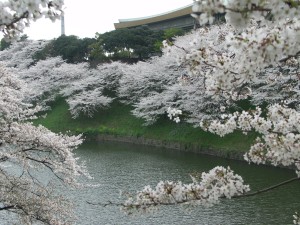
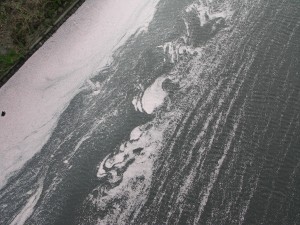
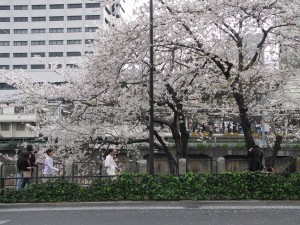 After exiting Ueno Park through the south gate, we make our way south to Akihabara (where, this time, we do not waste an hour playing video games) and then west from there to Ochanomizu. We stop to take photos at the Kanda Riverside opposite Ochanomizu Station, but this idiot in a minivan parks right in front of the tree we are trying to photograph. I guess his wife can sense our rage, because she convinces him to pull forward a few meters so we can shoot the tree. Then she hands him divorce papers and throws herself into the river, never to be seen again. Everybody wins.
After exiting Ueno Park through the south gate, we make our way south to Akihabara (where, this time, we do not waste an hour playing video games) and then west from there to Ochanomizu. We stop to take photos at the Kanda Riverside opposite Ochanomizu Station, but this idiot in a minivan parks right in front of the tree we are trying to photograph. I guess his wife can sense our rage, because she convinces him to pull forward a few meters so we can shoot the tree. Then she hands him divorce papers and throws herself into the river, never to be seen again. Everybody wins.
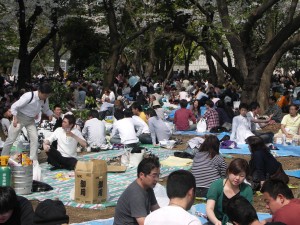 All of a sudden we're in Ueno, fighting through throngs of people carrying beer and frankfurters and takoyaki and yakisoba, stepping over blue plastic picnic sheets and apologizing to the guy who's lunch I just stepped on. Drunkenness is in the air and it's only 1:12 in the afternoon. This is what hanami is really all about.
All of a sudden we're in Ueno, fighting through throngs of people carrying beer and frankfurters and takoyaki and yakisoba, stepping over blue plastic picnic sheets and apologizing to the guy who's lunch I just stepped on. Drunkenness is in the air and it's only 1:12 in the afternoon. This is what hanami is really all about.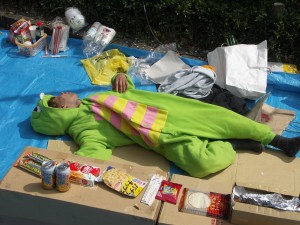
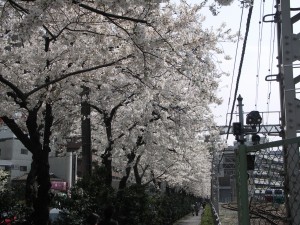 We pass Minowa and Iriya Stations and then start to get a little lost just before we reach Ueno. We decide to let the cherry blossoms guide us, and guide us they do. They guide us down this picturesque sidestreet that runs between Highway 4 and the many parallel train tracks that enter Ueno Station from the north. These will be the last moments of quiet before we reach Tokyo's noisiest, most crowded, most popular and perhaps most over-rated cherry blossom viewing zone of all: Ueno Park. (You might recall that I made a point of visiting Ueno Park on my first Big Walk and was subsequently disappointed. We are, however, determined to give it a chance to redeem itself.)
We pass Minowa and Iriya Stations and then start to get a little lost just before we reach Ueno. We decide to let the cherry blossoms guide us, and guide us they do. They guide us down this picturesque sidestreet that runs between Highway 4 and the many parallel train tracks that enter Ueno Station from the north. These will be the last moments of quiet before we reach Tokyo's noisiest, most crowded, most popular and perhaps most over-rated cherry blossom viewing zone of all: Ueno Park. (You might recall that I made a point of visiting Ueno Park on my first Big Walk and was subsequently disappointed. We are, however, determined to give it a chance to redeem itself.)
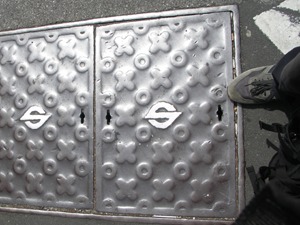 This is really dorky.
This is really dorky.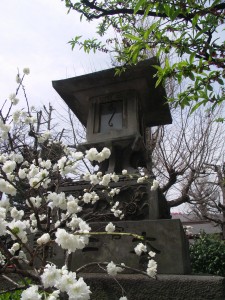 At 11:45 we cross the Sumida River and set foot in the only area I've been hesitant about including in this year's route: Minamisenju. I remember looking out the window of the Hibiya Line train years ago and seeing the area surrounding Minamisenju Station and thinking, "Wow, this place is poetically crappy." It was like an endless sea of transition tracks, boxcars and warehouses. And one time this old man with shit on his face -- literally, shit on his face -- got on the train at Minamisenju Station and tried to start a conversation with me. I was too polite to run away screaming and breathed a huge sign of relief when he got off the train at Iriya.
At 11:45 we cross the Sumida River and set foot in the only area I've been hesitant about including in this year's route: Minamisenju. I remember looking out the window of the Hibiya Line train years ago and seeing the area surrounding Minamisenju Station and thinking, "Wow, this place is poetically crappy." It was like an endless sea of transition tracks, boxcars and warehouses. And one time this old man with shit on his face -- literally, shit on his face -- got on the train at Minamisenju Station and tried to start a conversation with me. I was too polite to run away screaming and breathed a huge sign of relief when he got off the train at Iriya. All right, kids! It's Sunday, April 1 -- the peak of the 2007 cherry blossom season in central Tokyo -- which means it's time for the Third Annual Chorus, Isolate, Confirm Big Walk! This year's route differs slightly from years past, taking a north-to-south path rather than west-to-east. I take the Chiyoda Subway Line to Kitasenju Station in Adachi Ward, where I am met by my friend, co-worker and ex-housemate Craig at 11:00 AM.
All right, kids! It's Sunday, April 1 -- the peak of the 2007 cherry blossom season in central Tokyo -- which means it's time for the Third Annual Chorus, Isolate, Confirm Big Walk! This year's route differs slightly from years past, taking a north-to-south path rather than west-to-east. I take the Chiyoda Subway Line to Kitasenju Station in Adachi Ward, where I am met by my friend, co-worker and ex-housemate Craig at 11:00 AM.